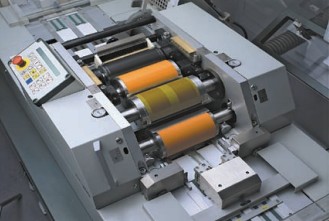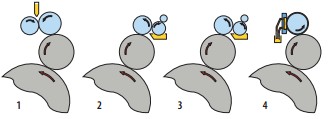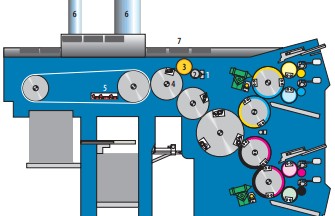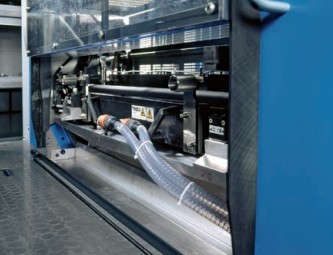In the past two decades, the online glazing options available on the market have been improved beyond recognition. In sheetfed offset printing, the numerous benefits provided by the anilox roller glazing device make them the most popular choice. KBA has been systematically promoting anilox roll glazing for many years, initially using it on Rapida and 74 Karat presses, and most recently on its own Performa presses. Although there are occasional customer requests for a roller glazing device as an alternative device on VLF (Very Large Format) presses, and this device can also be equipped as an optional device on KBA-Metronic's B3 (20 inch) Genius 52UV However, only Performa printers offer optional equipment for glazing via a water bucket. Varnishing with offset printing technology: On the OC200 printer for KBA-Metronic printing plastic cards, the UV primer and varnish are applied through an inkless key inking device specially modified for anhydrous UV ink. The anilox roller measures the varnish from the ink fountain On-line coating with offset printing technology In the standard sheet-fed offset printing, the last printing unit applies the printing varnish through the inking device, printing plate and blanket, which is the only glazing system still using offset printing technology. The use of this method in combination with composite consumables has demonstrated a new situation and can be used as an option to create complex gloss? Matte gloss contrast. On OCA of KBA-Metronic, when printing a single plastic card in groups of two with anhydrous UV offset printing ink, UV varnish can also be applied through the inking device, printing plate and blanket. Since OC200 has an inkless key inking device equipped with a temperature-controlled anilox metering roller, and there is a sufficient drying part behind the last printing unit, the quality of the gloss varnish obtained is exceptionally good. Before printing the first color, the same system can be used to apply the UV-curing primer that cures immediately. A more common method in the 1990s was to apply water-based varnishes through buckets and blankets, but today only users who rarely need to apply varnish use this method, so they are also ready to accept the resulting Quality damage. There are still some varnish manufacturers that provide optimized water-based varnishes, or water bucket varnishes as everyone knows. At the measuring position of the water hopper, a printing press manufacturer provides a modular cavity scraper attachment, which can be placed on the offset press where the blanket cleaning device can usually be seen. KBA did not intend to adopt this kind of method that is expected to be used for medium format printers that rarely perform glazing operations. The reason is obvious: the related printers are usually not equipped with a sufficient number of IR (infrared) and hot air drying devices, so the water-based varnish is generally not as dry as it should be. When the accessory can only apply field varnish This is especially true when it comes to time. Therefore, the idea of ​​inserting one such attachment before printing the first color on the first printing unit, or inserting two attachments for double-sided glazing in the case of drying between inorganic groups, would be too rash to take a step back. . KBA recommends that the water-based glazing oil be equipped with a special glazing device (which can also be used for partial glazing) plus appropriate drying techniques. From an economic point of view, this is very reasonable, because glazing is far from an exception but has become a practice, and can allow finishing operations on printed products as soon as possible. Online glazing with glazing device Only using one or more dedicated varnishing devices for on-line water-based? UV varnish application, it is possible to achieve excellent quality that can always be reproduced. These devices can apply a lot more varnish than other systems, and they can also measure the varnish more uniformly on the glazing plate. For field applications, it is customary to use smooth blankets, and for partial glazing, use peeled glazing blankets or photosensitive resin reliefs. On-line glazing device for sheet-fed printing presses: two-roll glazing device (“extrusion-type glazing deviceâ€) for measuring with a roll gap (1) and reverse operation (2), and synchronous three-roller Polishing device (3) and anilox roller polishing device (4) The most commonly used glazing devices were roller glazing devices of various types. The simplest design is the two-roller glazing device. This design is still the first choice in web printing. This is mainly due to its simple structure, which will not cause failure when the paper tape runs at high speed and frequent replacement applications. This is because gloss varnishes are used relatively less than rubber coatings, sizing, scratchable inks, or scented varnishes. The two-roll glazing device usually includes a rubber-coated hopper roller rotating in a glazing oil pan, a chrome-plated glazing plate roller and a glazing plate cylinder. The two-roller glazing device used in sheet-fed printing presses has been developed as a known extrusion glazing device. The rubber roller has been replaced by a chrome roller, and the varnish is applied through a slit in the tank placed above the nip. The amount of varnish applied is controlled by adjusting the size of the nip, so an extremely thick varnish layer can be applied. The rollers can rotate at different speeds, which means that the amount of varnish can be infinitely adjusted relative to the speed of the printing press. Varnishing device on KBA 74 Karat: pump water-based varnish from the varnish reservoir to the scraper cavity (1). An anilox roller (2) with a score of 100 threads? Cm (245 threads? Inches) applies a varnish of approximately 7 milliliters per square meter (0.02 fluid ounce? Square feet). A peelable blanket is attached to the glazing plate cylinder (3). The transfer cylinder has been modified to a glazing impression cylinder (4). A drying device (5) composed of four infrared radiators and three hot air knives dries the glazed printed sheets that are sent to the stack of paper from below them. An extractor system (6) removes water vapor. The outer casing (7) of the printing machine can be swung up to provide access to the glazing device for cleaning and maintenance work The three-roller glazing device is characterized by a hopper roller immersed in the glazing oil pan and a heavy roller mounted on it. The hopper roller can rotate in the same direction or reverse direction as the drum. The amount of varnish applied can be adjusted by adjusting the heavy roller and changing the speed and rotation direction of the roller. The result is more precise glazing control than the two-roll glazing device using a roll gap system. Although it is now believed that roll glazing devices are very outdated for small and medium format printing presses, there are still some manufacturers supplying such devices. The optional extruding glazing device is provided for Genius 52U of KBA-Metronic mainly because it can apply a very thick glazing oil film. Inplastor, the earliest user in Sweden, chose to squeeze the glazing device after testing multiple anilox rollers of the anilox roller glazing system in order to avoid using an offline glazing system to glaze the plastic cards printed on it. Nonetheless, the anilox roller glazing device is a representative of the state-of-the-art technology for sheet-fed printing presses. Because these devices are based on flexographic printing (a letterpress process), the glazing quality achieved is much better than offset printing, which is not only reflected in the uniformity of the entire field, but also in the local glazing Copy the details. The anilox roller glazing device consumes 15% less glazing oil than the roller glazing device. Although the anilox roller glazing device can not apply infinitely adjustable glazing oil film, but because it is only affected by the absorption and engraving anilox roller, that is, it is not related to the speed, so the application of glazing oil is extremely constant, and Can be reproduced reliably. Therefore, the anilox roller glazing device is different from the roller glazing device. It has lower technical requirements for the operator of the printing press and requires less monitoring work. Using an anilox roller glazing device can not only apply water-based and UV varnish, but also apply metallic and pearlescent varnish and opaque white paint. The amount of varnish applied can be determined and can be reproduced with the highest accuracy at any time. Buyers of Rapida and Performa 74 presses equipped with varnishing devices can choose between systems made by Harris & Bruno or Tresu, both of which provide automatic systems for varnish replacement. The anilox roll system manufactured by Tresu is installed on KBA's two waterless offset presses-74 Karat and Rapida 74G, and can provide Technotrans systems as an alternative. On 74 Karat and Rapida 74G, the varnish replacement system is an optional device because most users tend to use only one water-based varnish; only when applying pigment varnish or opaque white paint and printing The varnish must be replaced only when the paper is not a plastic diaphragm. The doctor blade cavity can either be rotated (Tresu) or moved laterally (Harris & Bruno) to allow you to access the anilox roller, two doctor blades and seals (see "Technology for automatic varnish replacement"). In both devices, the scraper cavity can be closed and left manually, making the operation very convenient. Sheet Paper,Offset Sheet,Offset Sheet Paper,White Sheet Paper Puyang Longfeng Paper Co.,Ltd. , https://www.lonfonpaper.com





